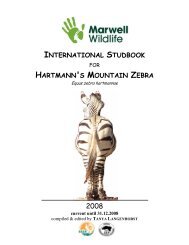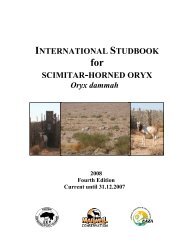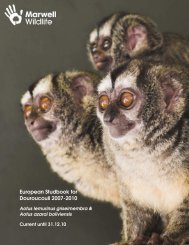Adaptation Trail - Marwell Wildlife
Adaptation Trail - Marwell Wildlife
Adaptation Trail - Marwell Wildlife
Create successful ePaper yourself
Turn your PDF publications into a flip-book with our unique Google optimized e-Paper software.
<strong>Adaptation</strong> <strong>Trail</strong><br />
Welcome to <strong>Marwell</strong> <strong>Wildlife</strong>!<br />
Name:<br />
You are about to go on a journey of discovery around the park to find out more<br />
about how different animals are suited to their environment.<br />
First, let’s remind ourselves about the types of habitats animals might live in as<br />
this might affect their adaptations. See if you can match up the habitats below<br />
with the correct picture and characteristics:<br />
Rainforest<br />
Desert<br />
Mountain<br />
Savanna<br />
Coastal<br />
Hot and dry, little plant<br />
life<br />
Hot, enough rainfall for<br />
grass growth<br />
Hot, high rainfall, tall<br />
trees and dense<br />
vegetation<br />
Can be steep/rocky,<br />
temperature decreases<br />
with altitude<br />
Where the sea meets<br />
the land
You will be looking at lots of different animals and the adaptations that they<br />
have to survive in different habitats.<br />
You will need to collect information on some of these animals and record it on<br />
the sheets provided – some of the information you will need is on signs on the<br />
animal enclosures; sometimes you have to watch the animals to work the<br />
answers out!<br />
1. HUMBOLDT PENGUIN<br />
What habitat does it live in?<br />
What are their wings like and what do these help penguins to do?<br />
What other adaptations help these birds to<br />
live? How?<br />
<strong>Adaptation</strong>:<br />
Useful because:<br />
<strong>Adaptation</strong>:<br />
Useful because:
2. CHEETAH<br />
What habitat do these cats live in?<br />
Can you spot this pattern on the cheetah?<br />
How might this pattern be useful to cheetah?<br />
Look at the skulls by the cheetah enclosure. What type of teeth does a<br />
cheetah have?<br />
How might these teeth be useful to cheetah?<br />
How does a cheetah skull differ to a leopard or lion skull?<br />
How might this adaptation help cheetah?<br />
Can you spot any other adaptations cheetah have to<br />
help them survive in their habitat? What might these<br />
be useful for?
3. CRESTED PORCUPINE<br />
The habitats these porcupines live in are<br />
Its most obvious adaptation is its<br />
These help it survive because<br />
4. BLACK AND WHITE COLOBUS MONKEY<br />
What habitat does it live in?<br />
Explain two adaptations these monkeys have to help<br />
them survive in their habitat:<br />
1.<br />
Useful for:<br />
2.<br />
Useful for:
5. GIRAFFE<br />
This is the tallest land animal in the world.<br />
What habitat does it live in?<br />
What two adaptations do giraffes have to make them so tall?<br />
1.<br />
2.<br />
Give two reasons why being so tall is useful for a giraffe:<br />
1.<br />
2.<br />
A giraffe’s tongue is 46-50cm long.<br />
Why is this useful to giraffes?
6. SAND CAT<br />
What type of habitat do these cats live in?<br />
Use the information boards to find out:<br />
a. How hot it gets during the day in the Sahara °C<br />
b. How cold it can get at night in the Sahara °C<br />
What main adaptation do sand cats have to<br />
help them live in this climate? How does this<br />
help them?<br />
How can it behave to help it survive<br />
these harsh temperatures? What adaptation<br />
does it have to allow it to do this?<br />
Survival strategy:<br />
<strong>Adaptation</strong>:
7. OCELOT<br />
What habitat does it live in?<br />
In what two ways is an ocelot similar to a soldier?<br />
1.<br />
2.<br />
How do these two adaptations help it to survive in<br />
its habitat?<br />
8. RING-TAILED COATI<br />
What type of habitat does it live in?<br />
Can you identify and explain two adaptations that help it to live there?<br />
<strong>Adaptation</strong>:<br />
Useful because:<br />
<strong>Adaptation</strong>:<br />
Useful because:<br />
What special feature does this animal have that allows it to walk down trees<br />
headfirst?
9. BACTRIAN CAMEL<br />
This species has 2 possible locations on the map, depending on the season. It<br />
is near Encounter Village in the winter and near the sand cats in the summer.<br />
Which habitat is the camel adapted for?<br />
Add annotations (labels with explanations) to the camel below to show what<br />
adaptations it has to help it survive in its habitat. An example has been done for<br />
you:<br />
Nostrils are slits<br />
that can open and<br />
close to keep sand<br />
out in sandstorms
10. BAT-EARED FOX<br />
What type of habitat do these animals live in?<br />
“Why does the bat-eared fox follow the zebra?” – Using the signs around the<br />
enclosure complete the comic strip below by adding pictures/captions to<br />
answer this question.<br />
1. Zebras eat grass<br />
2. Zebras poo<br />
So why do bat-eared foxes follow zebras?<br />
Complete the table below to show what adaptations the bat-eared fox has to<br />
support this diet:<br />
<strong>Adaptation</strong><br />
Sketch of<br />
adaptation<br />
5. Eggs hatch into<br />
larvae<br />
6. The larvae eat the<br />
zebra poo<br />
Useful because...
11. SULAWESI CRESTED MACAQUE<br />
What habitat do they live in?<br />
What special features do the macaques have?<br />
How are these useful?<br />
12. SIAMANG GIBBON<br />
In which type of habitat are these gibbons found?<br />
Identify 3 adaptations these gibbons have to help them move through the trees:<br />
1.<br />
2.<br />
3.<br />
Listen out for gibbons whooping as you go around the park! Siamang gibbons<br />
have an inflatable throat sac that allows their hooting to travel long distances.<br />
Why might this be useful in the habitat they live in?
13. MALAYSIAN GIANT STICK INSECT<br />
What habitat do these insects live in?<br />
What main adaptation do they have to help them survive? Why is this so useful?<br />
Challenge: How many stick insects can you spot?!<br />
14. RING-TAILED LEMUR<br />
What habitat do ring-tailed lemurs live in?<br />
Suggest two adaptations that these lemurs have to help them live in this habitat<br />
1.<br />
2.<br />
At one end of the lemur house is a sign with flaps you can<br />
lift up. Use this to explain why lemurs have forward-facing<br />
eyes:
15. SNOW LEOPARD<br />
The habitat you would find snow leopards in is<br />
Try to add at least 3 annotations to the snow leopard below to explain what<br />
adaptations it has to help it live in its habitat. An example has been done for you.<br />
In the box sketch the markings found on snow leopards.<br />
Explain how these markings might be useful to the snow<br />
leopard.<br />
Strong legs/paws to catch<br />
its prey and help it move<br />
easily though rocky areas
16. PYGMY HIPPO<br />
What habitat does it live in?<br />
What adaptations does it have to allow it to hide underwater but still see, hear<br />
and breathe?<br />
What does the sticky substance produced by the pygmy hippo’s skin protect it<br />
from?<br />
17. GIANT ANTEATER<br />
In what habitats would you find these animals?<br />
What type of food does this animal eat?<br />
What two adaptations does it have that would help it to feed? How?<br />
<strong>Adaptation</strong>:<br />
This helps it feed because:<br />
<strong>Adaptation</strong>:<br />
This helps it feed because:
Animals of <strong>Adaptation</strong> <strong>Trail</strong> 9 9. Bactrian camel<br />
1. 1 Humboldt penguin<br />
10 10. Bat eared fox<br />
2. 2 Cheetah<br />
11 11. Sulawesi crested macaque<br />
3. 3 Crested porcupine<br />
12 12. Siamang gibbon<br />
4. 4 Black and white colobus monkey<br />
13 13. Malaysian giant stick insect<br />
5. 5 Giraffe<br />
14 14. Ring-tailed lemur<br />
6. 6 Sand cat<br />
15 15. Snow leopard<br />
7. 7 Ocelot<br />
16 16. Pygmy hippo<br />
8. 8 Coati<br />
17 17. Giant anteater<br />
Cold-blooded corner<br />
5<br />
9<br />
6<br />
10<br />
7<br />
8<br />
3, 4<br />
Tropical World<br />
5<br />
2<br />
1<br />
9<br />
14<br />
16<br />
12<br />
13<br />
11<br />
17<br />
15
Activity answers<br />
<strong>Adaptation</strong> trail<br />
1. Humboldt penguin<br />
Habitat: Rocky coasts and cool waters<br />
Wings: Act as flippers to help them swim<br />
Other adaptations: Beak has small teeth to keep hold of fish; waterproof feathers; streamlined body<br />
to move quickly through water; black and white camouflage so can’t be easily seen by predators<br />
2. Cheetah<br />
Habitat: Desert, grasslands, bushveld, mountainous areas<br />
Pattern useful for: Camouflage – helps them to hide from their prey in savanna grasses<br />
Teeth: Big teeth – sharp canines, strong incisors – used for catching and eating their prey<br />
Skull: Smaller than leopard/lion skull – helps cheetah to be streamlined for running at speed<br />
Other adaptations: Long, slim legs for running fast; Long flat tail that allows it to change direction<br />
when chasing its prey at speed<br />
3. Crested porcupine<br />
Habitats: Many habitats from forest to desert<br />
Obvious adaptation: Quills<br />
Helps it survive by: Defence against predators, can shake them to make them rattle or run at<br />
attacker and stick quills into them<br />
4. Black and white colobus monkey<br />
Habitat: Rainforest<br />
<strong>Adaptation</strong>s: Long arms – for swinging between trees, moving along branches; Long tail – acts as a<br />
brake or used for balance<br />
5. Giraffe<br />
Habitat: Savanna or dry, open country and woodland<br />
<strong>Adaptation</strong>s to make it tall: Long legs; Long neck<br />
Why being tall is useful: Helps giraffe to reach food; Can look out for danger<br />
Long tongue: Useful for grabbing and picking leaves to eat<br />
6. Sand cat<br />
Habitat: Sandy desert<br />
How hot?: 58°C<br />
How cold?: -5°C or -25°C (winter)<br />
<strong>Adaptation</strong> to survive climate: Special solid, dense fur that insulates them<br />
Survival strategy: Digs burrows to get shade;<br />
<strong>Adaptation</strong> for this – Strong legs
7. Ocelot<br />
Habitat: Forests, scrubland and savanna<br />
Similarities to a soldier: Waterproof coat; Camouflaged (Found on information board)<br />
How these similarities help ocelot to survive in its habitat: Oily coat to waterproof it in wet<br />
rainforest; Uses colours and patterns on its coat to camouflage it to help it hide from its prey<br />
8. Ring-tailed coati<br />
Habitat: Forests and woods<br />
<strong>Adaptation</strong>s: Strong short legs and claws to help it climb; Narrow nose to search for food; Thick fur to<br />
keep it warm; Long tail to help it balance<br />
Special feature: They can turn their ankles 180° (Found on information board)<br />
9. Bactrian camel<br />
Habitat: Semi-arid to arid plains, grasslands and desert<br />
<strong>Adaptation</strong>s: Wide feet to spread out weight and stop camel sinking in the sand; Hump to store fat<br />
when food and water is scarce; Long eyelashes to keep sand out of eyes; Sandy coloured for<br />
camouflage<br />
10. Bat-eared fox<br />
Habitat: Savanna, plains, grassland and steppes<br />
1. Zebras eat grass<br />
2. Zebras poo<br />
3. Dung beetles roll<br />
up the poo<br />
4. Dung beetles lay<br />
their eggs into the poo<br />
5. Eggs hatch into<br />
larvae<br />
6. The larvae eat the<br />
zebra poo<br />
7. Bat-eared foxes<br />
love to eat dung<br />
beetle larvae<br />
Why do bat-eared foxes follow zebras? Where there are zebras there is fox food!<br />
<strong>Adaptation</strong>s: Big ears to listen for and find underground bugs; Needle-like teeth to eat bugs more<br />
easily and quickly as need to eat really fast to fill up on bugs<br />
11. Sulawesi crested macaque<br />
Habitat: Tropical forest<br />
Special features: Crest on head – raises when anxious/alarmed; Pink bottom – perhaps helps them<br />
see each other better in the forest – becomes bigger on a female when she is ready to breed; Cheek<br />
pouches – can hold as much food as stomach
12. Siamang gibbon<br />
Habitat: Tropical rainforest<br />
<strong>Adaptation</strong>s: Long arms for swinging through trees; Long fingers to grip branches; Forward facing<br />
eyes to judge distances<br />
Why might whooping be useful?: To communicate with each other in dense rainforest; to mark their<br />
territory<br />
13. Malaysian giant stick insect<br />
Habitat: Forests<br />
Main adaptation: Camouflage – helps them to hide from predators<br />
14. Ring-tailed lemurs<br />
Habitat: Scrub and forest<br />
<strong>Adaptation</strong>s: Long tail for balance; Long fingers for gripping branches<br />
Forward facing eyes: For judging distances when moving through trees<br />
15. Snow leopard<br />
Habitat: Cold mountains<br />
<strong>Adaptation</strong>s: Thick fur to protect against the cold; Large paws to spread weight so it can move easily<br />
through the snow; Long tail for balance when moving through rocky areas; Furry tail can be wrapped<br />
over the face to keep it warm when resting; Large teeth for killing and eating prey<br />
Markings: Help snow leopard camouflage to help it hide from and sneak up on its prey<br />
16. Pygmy hippo<br />
Habitat: Wet forests, swamps and streams<br />
<strong>Adaptation</strong>s for hiding under water: Their ears, eyes and nose are on the top of their head<br />
Sticky substance protects it from: The sun – acts as a kind of sunscreen<br />
17. Giant anteater<br />
Habitat: Grasslands and forests<br />
Diet: Ants, beetles, termites and fruit<br />
<strong>Adaptation</strong>s: Strong legs and claws to break into termite mounds/reach ants/termites; Long nose to<br />
sense ants/termites; Long tongue to pick up ants/termites
















